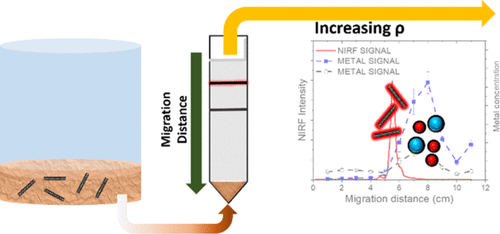当前位置:
X-MOL 学术
›
Environ. Sci. Technol.
›
论文详情
Our official English website, www.x-mol.net, welcomes your feedback! (Note: you will need to create a separate account there.)
Analysis of Single-Walled Carbon Nanotubes in Estuarine Sediments by Density Gradient Ultracentrifugation Coupled to Near-Infrared Fluorescence Spectroscopy Reveals Disassociation of Residual Metal Catalyst Nanoparticles
Environmental Science & Technology ( IF 11.4 ) Pub Date : 2020-12-29 , DOI: 10.1021/acs.est.0c06058 Manuel D. Montaño 1, 2, 3 , Keira Liu 2, 4 , Tara Sabo-Attwood 5 , P. Lee Ferguson 2, 3
Environmental Science & Technology ( IF 11.4 ) Pub Date : 2020-12-29 , DOI: 10.1021/acs.est.0c06058 Manuel D. Montaño 1, 2, 3 , Keira Liu 2, 4 , Tara Sabo-Attwood 5 , P. Lee Ferguson 2, 3
Affiliation

|
The continued growth of the nanotechnology industry and the incorporation of nanomaterials into consumer applications will inevitably lead to their release into environmental systems. Single-walled carbon nanotubes (SWCNTs) in particular have exhibited many attractive optical, mechanical, and electrical properties that lend themselves to new and exciting applications. Assessing their environmental impact upon release into the environment is contingent upon quantifying and characterizing SWCNTs in environmental matrixes. In this study, SWCNTs were isolated from estuarine sediments using density gradient ultracentrifugation (DGU), followed by online flow-through analysis of the density fractions via near-infrared spectroscopy. This approach yielded significant improvements in the quantitative detection limit, from 62 to 1.5 μg g–1. In addition, fractions of the density gradient were also obtained for further analysis by bulk inductively coupled plasma mass spectrometry (ICP–MS) and single-particle ICP–MS. Using fluorescent, semiconductive SWCNTs, the primary fluorescent nanotube fraction was found to be separated from the sediment matrix during DGU; however, the residual metal catalyst particles that had been assumed to be physically bound to the SWCNTs were found to form a separate band in the density gradient apart from the fluorescent SWCNTs. This result was repeated for a number of SWCNT types regardless of the metal catalyst and synthesis method, with a 0.1 g cm–3 density difference between most fractions. The apparent disconnect between the fluorescent fraction of SWCNTs and their metal-containing constituents potentially complicates CNT risk assessment as analysis techniques focusing solely on either CNT fluorescence or metal fingerprints may misrepresent exposure concentrations and their toxicological implications.
中文翻译:

密度梯度超速离心结合近红外荧光光谱法分析河口沉积物中的单壁碳纳米管揭示了残余金属催化剂纳米粒子的解离
纳米技术行业的持续增长以及将纳米材料纳入消费类应用将不可避免地导致其释放到环境系统中。特别是单壁碳纳米管(SWCNT)表现出许多吸引人的光学,机械和电学性质,使其适合新颖的应用。评估它们在释放到环境中时对环境的影响取决于量化和表征环境基质中的SWCNT。在这项研究中,使用密度梯度超速离心(DGU)从河口沉积物中分离出SWCNT,然后通过近红外光谱在线分析密度部分。这种方法使定量检测限从62μgg显着提高到1.5μgg–1。此外,还通过体积电感耦合等离子体质谱法(ICP-MS)和单颗粒ICP-MS获得了密度梯度的分数,用于进一步分析。使用荧光的半导电SWCNT,发现在DGU过程中主要的荧光纳米管级分与沉积物基质分离。然而,发现假定已经物理结合到SWCNT的残余金属催化剂颗粒在密度梯度中与荧光SWCNT分开形成单独的谱带。无论使用何种金属催化剂和合成方法,对于多种SWCNT类型,其重复结果均为0.1 g cm –3大多数馏分之间的密度差。SWCNTs的荧光部分与其含金属的成分之间明显的脱节可能会使CNT风险评估变得复杂,因为仅专注于CNT荧光或金属指纹的分析技术可能会误解暴露浓度及其毒理学含义。
更新日期:2021-01-19
中文翻译:

密度梯度超速离心结合近红外荧光光谱法分析河口沉积物中的单壁碳纳米管揭示了残余金属催化剂纳米粒子的解离
纳米技术行业的持续增长以及将纳米材料纳入消费类应用将不可避免地导致其释放到环境系统中。特别是单壁碳纳米管(SWCNT)表现出许多吸引人的光学,机械和电学性质,使其适合新颖的应用。评估它们在释放到环境中时对环境的影响取决于量化和表征环境基质中的SWCNT。在这项研究中,使用密度梯度超速离心(DGU)从河口沉积物中分离出SWCNT,然后通过近红外光谱在线分析密度部分。这种方法使定量检测限从62μgg显着提高到1.5μgg–1。此外,还通过体积电感耦合等离子体质谱法(ICP-MS)和单颗粒ICP-MS获得了密度梯度的分数,用于进一步分析。使用荧光的半导电SWCNT,发现在DGU过程中主要的荧光纳米管级分与沉积物基质分离。然而,发现假定已经物理结合到SWCNT的残余金属催化剂颗粒在密度梯度中与荧光SWCNT分开形成单独的谱带。无论使用何种金属催化剂和合成方法,对于多种SWCNT类型,其重复结果均为0.1 g cm –3大多数馏分之间的密度差。SWCNTs的荧光部分与其含金属的成分之间明显的脱节可能会使CNT风险评估变得复杂,因为仅专注于CNT荧光或金属指纹的分析技术可能会误解暴露浓度及其毒理学含义。



























 京公网安备 11010802027423号
京公网安备 11010802027423号